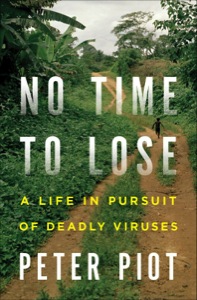
No Time to Lose by Peter Piot
It’s 10 minutes after the hour, and you’ve done it again.
You hate missing the first part of your favorite show. Call it obsession, call it silly, but you have to see it from the start or you don’t feel it’s worth watching at all. Yes, you could figure out what happened, but it’s just not the same.
Author and epidemiologist Peter Piot knows what it’s like to be on the ground-floor of something important. He was there when two previously unknown viruses were identified, and in No Time to Lose, he explains what that was like.
The package arrived in a blue plastic thermos. It wasn’t wrapped well; in fact, one of the vials inside had broken, mixing glass with blood that had been taken from a Belgian nun who bled to death in Zaire, for reasons no one could explain.
Peter Piot was an infectious disease researcher in Antwerp, and this kind of mystery made his “heart beat faster.” When his boss sent him to Kinshasa, along the river Congo, to learn more about the crisis, Piot was even more excited. He became part of a team that teased out the root of the sickness, and how it traveled from patient to victim.
The virus, highly contagious and almost always deadly, was later named after a river in Africa. Piot is still aghast at the careless, cavalier attitude given to that initial, highly dangerous flask of Ebola he encountered.
After his work in Africa ended, Piot went to Swaziland to work with a colleague assigned to eliminate sexually transmitted disease there. The endeavor was, of course, ill-fated, but this led him to work with STD patients in Antwerp. There, an alarming situation was just starting to appear in the city’s gay population. It “seemed to be a new syndrome” and it seemed to be on the rise.
It was a virus that didn’t care “whether the sex is good, or about the color or gender of the person …” Researchers called it GRID at first, then they renamed it AIDS.
Almost from the opening pages, No Time to Lose immerses readers in excitement. Author Peter Piot does such a fine job in describing his African surroundings and the people there that you can almost hear the surrounding jungle.
But Piot’s story is not meant for entertainment. There’s a heightened sense of urgency and force here; in fact, Piot repeatedly admits regret that he didn’t do enough, soon enough. Looking through a backward lens, though, readers will wonder why he questions himself: he writes of fighting bureaucracy and politics, establishing organizations to study and prevent infection, and the now-outrageous beliefs he battled.
That makes this a triumphant book with a coda of sadness for a job that seemed, to the author, unfinished.
This book is serious stuff and it’s filled with scientific terms, acronyms and world politics – but don’t let that scare you away. If you’ve got the time to give it the attention it deserves, you’ll enjoy No Time to Lose from the start.











